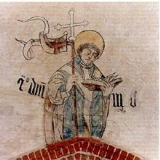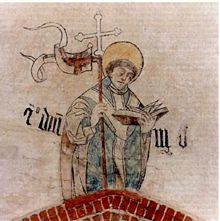
Lebuinus
Encyclopedia

Frisians
The Frisians are a Germanic ethnic group native to the coastal parts of the Netherlands and Germany. They are concentrated in the Dutch provinces of Friesland and Groningen and, in Germany, East Frisia and North Frisia, that was a part of Denmark until 1864. They inhabit an area known as Frisia...
and patron of Deventer
Deventer
Deventer is a municipality and city in the Salland region of the Dutch province of Overijssel. Deventer is largely situated on the east bank of the river IJssel, but also has a small part of its territory on the west bank. In 2005 the municipality of Bathmen Deventer is a municipality and city in...
(born in England
England
England is a country that is part of the United Kingdom. It shares land borders with Scotland to the north and Wales to the west; the Irish Sea is to the north west, the Celtic Sea to the south west, with the North Sea to the east and the English Channel to the south separating it from continental...
of Anglo-Saxon
Anglo-Saxons
Anglo-Saxon is a term used by historians to designate the Germanic tribes who invaded and settled the south and east of Great Britain beginning in the early 5th century AD, and the period from their creation of the English nation to the Norman conquest. The Anglo-Saxon Era denotes the period of...
parents, date unknown; died at Deventer c. 775).
Life
Lebuinus was a monk in WilfridWilfrid
Wilfrid was an English bishop and saint. Born a Northumbrian noble, he entered religious life as a teenager and studied at Lindisfarne, at Canterbury, in Gaul, and at Rome; he returned to Northumbria in about 660, and became the abbot of a newly founded monastery at Ripon...
's monastery at Ripon
Ripon
Ripon is a cathedral city, market town and successor parish in the Borough of Harrogate, North Yorkshire, England, located at the confluence of two streams of the River Ure in the form of the Laver and Skell. The city is noted for its main feature the Ripon Cathedral which is architecturally...
. Inspired by the example of Saint Boniface
Saint Boniface
Saint Boniface , the Apostle of the Germans, born Winfrid, Wynfrith, or Wynfryth in the kingdom of Wessex, probably at Crediton , was a missionary who propagated Christianity in the Frankish Empire during the 8th century. He is the patron saint of Germany and the first archbishop of Mainz...
, Saint Willibrord and other great English missionaries, he resolved to devote his life to the conversion of the Germans
Germany
Germany , officially the Federal Republic of Germany , is a federal parliamentary republic in Europe. The country consists of 16 states while the capital and largest city is Berlin. Germany covers an area of 357,021 km2 and has a largely temperate seasonal climate...
.
After his ordination he proceeded in 754 to Utrecht
Roman Catholic Archdiocese of Utrecht
The Archdiocese of Utrecht is an archdiocese of the Catholic Church in the Netherlands. The archdiocese is the metropolitan for 6 suffragans, the dioceses of Breda, Groningen-Leeuwarden, Haarlem-Amsterdam, Roermond, Rotterdam, and 's-Hertogenbosch....
, and was welcomed by Saint Gregory, acting bishop of that place, who entrusted him with the mission of Overijssel
Overijssel
Overijssel is a province of the Netherlands in the central eastern part of the country. The region has a NUTS classification of NL21. The province's name means "Lands across river IJssel". The capital city of Overijssel is Zwolle and the largest city is Enschede...
on the borders of Westphalia
Westphalia
Westphalia is a region in Germany, centred on the cities of Arnsberg, Bielefeld, Dortmund, Minden and Münster.Westphalia is roughly the region between the rivers Rhine and Weser, located north and south of the Ruhr River. No exact definition of borders can be given, because the name "Westphalia"...
, and gave him as a companion Marchelm (or Marcellinus), a disciple of Saint Willibrord.
He preached the Gospel among the tribes of the district, and erected a little chapel at Wilp (see: Voorst
Voorst
Voorst is a municipality and a town in the eastern Netherlands.- Population centres :* Appen * Bussloo...
) (Wilpa) on the west bank of the IJssel
IJssel
River IJssel , sometimes called Gelderse IJssel to avoid confusion with its Hollandse IJssel namesake in the west of the Netherlands, is a branch of the Rhine in the Dutch provinces of Gelderland and Overijssel...
. His venerable personality and deep learning quickly won many to Christianity
Christianity
Christianity is a monotheistic religion based on the life and teachings of Jesus as presented in canonical gospels and other New Testament writings...
, even among the nobles, and it soon became necessary to build at Deventer on the east bank of the river a larger church.
However, Lebuinus's great success aroused hostility among the pagans. Ascribing his conversions to witchcraft, they formed an alliance with the anti-Christian Saxons
Saxons
The Saxons were a confederation of Germanic tribes originating on the North German plain. The Saxons earliest known area of settlement is Northern Albingia, an area approximately that of modern Holstein...
, burned the church at Deventer and dispersed the converts.
After escaping with difficulty, Lebuinus determined to voice the claims of Christianity at the national assembly (Allthing) of the Saxons at Marclo (or Marklo) near the Weser.
The Vitae of Lebuinus describe in great detail his appearance before the assembly, where, it is claimed, he pointed out to the Saxons the inefficacy of their deities and warned them of impending destruction at the hands of a powerful king unless they converted to Christianity, and with the intercession of the nobleman Buto persuaded them sufficiently of the power of his mission that they not only allowed him to escape with his life but from then on to preach unmolested in the territory allotted him. His life may have been a source of inspiration in the creation of the cultus on Saint Livinus of Ghent
Ghent
Ghent is a city and a municipality located in the Flemish region of Belgium. It is the capital and biggest city of the East Flanders province. The city started as a settlement at the confluence of the Rivers Scheldt and Lys and in the Middle Ages became one of the largest and richest cities of...
.
Death
On his return to Friesland, Lebuinus rebuilt the church at Deventer, where he was also buried. That he died before 776 is certain, since in that year the Saxons made a fresh inroad into the district and burnt the church, but, in spite of searching for three days, were unable to discover the saint's body. Saint LudgerLudger
Saint Ludger was a missionary among the Frisians and Saxons, founder of Werden Abbey and first Bishop of Münster in Westphalia....
rebuilt the church a few years later, and found the saint's remains.
Primary sources
- Lives of St Lebuinus:
- Vita (Lebuini) antiqua, earliest Life (9th or early 10th century)
- Hucbald of Saint-Amand, Vita Lebuini (between 918 and 930).
- ed. ; ed. Patrologia LatinaPatrologia LatinaThe Patrologia Latina is an enormous collection of the writings of the Church Fathers and other ecclesiastical writers published by Jacques-Paul Migne between 1844 and 1855, with indices published between 1862 and 1865....
132, pp. 877–94; MGH Scriptores 2, pp. 360–4, in abbreviated form. - tr.
- ed. ; ed. Patrologia Latina
- 15th-century Life
- Radbod, Ecloga et Sermo (on Lebuinus), in Surius, VI, 839
- AltfridAltfridSaint Altfrid was a leading figure in Germany in the ninth century. A Benedictine monk, he became Bishop of Hildesheim, and founded Essen Abbey. He was also a close royal adviser to the East Frankish King Louis the German.He is a Roman Catholic saint...
, Vita Liutgeri in MGH Scriptores, II, 360 sqq.

